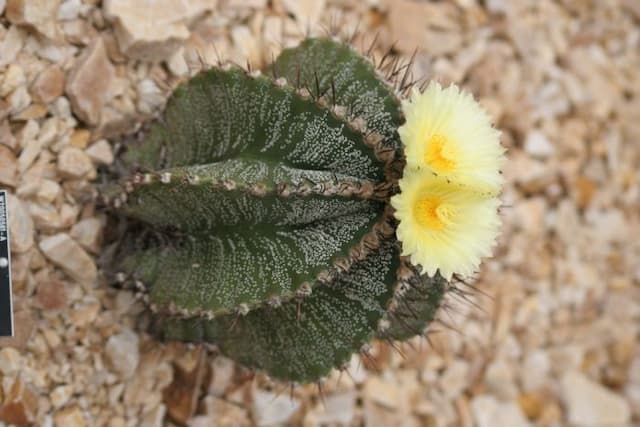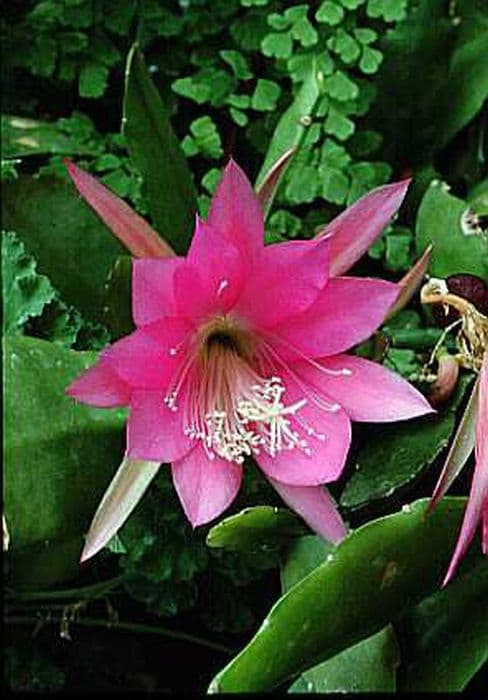Old Man of the Andes Oreocereus pseudofossulatus

ABOUT
The plant known commonly as the Old Man of the Andes cactus has a distinctive and striking appearance. It is characterized by its cylindrical shape with rows of ridges running vertically along its body. This cactus is covered with long, silvery-white hairs, which can give it a somewhat shaggy appearance that contributes to its memorable common name. These hairs provide the cactus with a layer of protection from the intense sun. The surface underneath the hairs can be seen to have areoles, which are small cushioned spots where spines and hairs emerge. From these areoles, one can generally see both long and short spines which can vary in color from dark to golden. These spines are quite stiff and sharp, aiding in the defense of the plant against herbivores. When the season is right, the plant produces flowers. These blooms are typically funnel-shaped and can come in colors such as red or sometimes pink, adding to the overall visual interest of the plant. After the flowering period, the plant may bear fruit which also emerges from the areoles. Overall, the Old Man of the Andes presents a fascinating combination of its prominent hairy covering and its robust, spiky defenses, all of which draw interest and curiosity from cacti enthusiasts and gardeners looking for a unique addition to their collection.
About this plant
 Names
NamesFamily
Cactaceae.
Synonyms
Old Man of the Andes, Cotton Column Cactus, Cotton Pole Cactus.
Common names
Oreocereus pseudofossulatus.
 Toxicity
ToxicityTo humans
Old Man of the Andes, which is the most common name for Oreocereus pseudofossulatus, is not known to be toxic to humans. However, as with many cacti, handling the spines can cause physical irritation or injury. Ingesting parts of the plant is not advisable, but there is no well-documented evidence of poisoning in humans from consuming this cactus.
To pets
For pets, the Old Man of the Andes cactus is similarly not known to be toxic. While the cactus itself isn't poisonous, the sharp spines can cause physical harm to pets if they come into contact with or attempt to ingest them. This could lead to injuries in the mouth, throat, or stomach. Pet owners should keep cacti out of reach to prevent these potential injuries.
 Characteristics
CharacteristicsLife cycle
Perennials
Foliage type
Evergreen
Color of leaves
Varies
Flower color
Red
Height
3 feet [0.91 meters]
Spread
18 inches [0.46 meters]
Plant type
Cactus
Hardiness zones
8
Native area
South America
Benefits
 General Benefits
General Benefits- Aesthetic Value: Oreocereus pseudofossulatus, also known as the Old Man of the Andes, adds a unique visual appeal to gardens with its columnar shape and hairy spines that can provide an interesting texture to landscapes.
- Drought Tolerance: Well-suited to arid environments, this cactus is highly drought-resistant, requiring minimal watering and care, which is ideal for water conservation in gardening practices.
- Low Maintenance: It has minimal nutritional needs and does not require frequent fertilization, making it a low-maintenance choice for gardeners.
- Suitable for Containers: Its manageable size and growth rate make it suitable for container gardening, allowing it to be kept on patios or indoors where space is limited.
- Adaptability: The Old Man of the Andes can adapt to a variety of light conditions, though it prefers full sun, making it versatile for different garden settings.
- Erosion Control: When planted in groups outdoors, its root system can help stabilize soil and control erosion in certain landscapes.
 Medical Properties
Medical PropertiesThis plant is not used for medical purposes.
 Air-purifying Qualities
Air-purifying QualitiesThis plant is not specifically known for air purifying qualities.
 Other Uses
Other Uses- Oreocereus pseudofossulatus, commonly known as the Old Man of the Andes cactus, can be used in themed gardens for its distinctive hairy appearance which adds a unique texture amidst other plants.
- These cacti are often used as living barriers in gardens due to their spiky surface, deterring animals and unauthorized access to certain areas.
- In photography and film, the Old Man of the Andes can be utilized as a visually interesting subject or as part of a backdrop in desert scenes.
- Due to its elongated growth form, it serves as an excellent conversation piece when potted and placed in patio areas or used in landscaping to provide a focal point.
- The Old Man of the Andes can be given as a gift to enthusiasts who appreciate low-maintenance and slow-growing plants.
- Its ability to withstand cold temperatures can make it a suitable candidate for rockeries and alpine gardens which mimic high altitude conditions.
- The plant's fibrous hairs have been experimentally used in crafting and textile work, when properly treated and dyed.
- It can be used in educational settings to teach about plant adaptations, specifically how certain features like hair help in survival in high altitude, high UV environments.
- As part of landscaping in large spaces, the Old Man of the Andes cactus can serve as a natural bird nesting site due to its protective spines and structure.
- The cactus can be displayed in botanical collections that focus on showcasing varieties of high-altitude plant species.
Interesting Facts
 Feng Shui
Feng ShuiThe Old Man of the Andes is not used in Feng Shui practice.
 Zodiac Sign Compitability
Zodiac Sign CompitabilityThe Old Man of the Andes is not used in astrology practice.
 Plant Symbolism
Plant Symbolism- Perseverance: Oreocereus pseudofossulatus, also known as the Old Man of the Andes, is a cactus that thrives in harsh, arid environments, symbolizing the ability to persevere and endure difficult conditions.
- Protection: With its spiny exterior, the Old Man of the Andes is often seen as a symbol of protection, guarding against negative forces and providing a defensive barrier.
- Longevity: This plant is known for its slow-growing nature and long lifespan, making it a symbol of longevity and the wisdom that comes with age.
- Self-Sufficiency: As a succulent, the Old Man of the Andes is highly adapted to storing water, representing self-sufficiency and the ability to sustain oneself.
- Adaptability: Its capacity to survive with minimal resources in high altitude environments symbolizes adaptability and resilience in the face of change.
 Water
WaterThe Old Man of the Andes cactus, or Oreocereus pseudofossulatus, prefers to be watered infrequently but thoroughly. It should be watered when the soil is completely dry, which could be every 7-10 days during the active growing season in spring and summer. During the dormant winter period, reduce watering to once a month. The amount of water should be enough to thoroughly saturate the soil, which is typically between 8-12 ounces, depending on the size of the pot. Always ensure that excess water is able to drain freely to avoid root rot.
 Light
LightThe Old Man of the Andes cactus thrives in bright, direct sunlight for several hours each day. Ideally, place it in a south-facing window where it can receive at least 6 hours of sunlight daily. If grown outdoors, ensure it is in a spot that is exposed to full sun. Inadequate light can lead to weak, stunted growth, so proper lighting is essential for this cactus's health.
 Temperature
TemperatureThe Old Man of the Andes cactus prefers a temperature range of about 50-80 degrees Fahrenheit. It can tolerate temperatures as low as 20 degrees Fahrenheit for short periods, making it a relatively cold-hardy cactus. However, it thrives in the warm temperatures typical of its native Andean mountain environment. During the summer, it can endure higher temperatures as long as there is adequate ventilation.
 Pruning
PruningPruning of the Old Man of the Andes cactus is typically not necessary, as it is a slow-growing plant. However, if it becomes necessary to shape the cactus or remove a damaged or diseased segment, pruning should be done carefully with clean, sterilized cutting tools. The best time for pruning is in the spring, just before the active growing season begins.
 Cleaning
CleaningAs needed
 Soil
SoilThe Old Man of the Andes cactus requires a well-draining soil mixture, typically made with a mix of regular cactus soil and perlite or pumice for added drainage. A preferred soil pH for this plant ranges from 6.0 to 7.5.
 Repotting
RepottingOld Man of the Andes should generally be repotted every two to three years, or when it outgrows its current container, to ensure the health of the roots and provide fresh nutrients.
 Humidity & Misting
Humidity & MistingOld Man of the Andes cactus does well in low humidity settings typical of arid environments, consistent with its native habitat.
 Suitable locations
Suitable locationsIndoor
Place in bright, indirect light and ensure pot has drainage.
Outdoor
Needs full sun to partial shade and protection from heavy rain.
Hardiness zone
10a-12 USDA
 Life cycle
Life cycleOreocereus pseudofossulatus, commonly known as the Old Man of the Andes cactus, begins its life cycle with the germination of seeds, typically occurring in well-draining, warm soil conditions. After germination, the seedling stage initiates, characterized by the growth of a small, cylindrical stem and the development of spiny areoles, indicating the cactus's slow progression towards maturity. As the plant enters the juvenile stage, it begins to exhibit the distinctive wooly hairs that protect it from harsh sunlight and cold temperatures found in its native high-altitude habitats. During the mature stage, the Old Man of the Andes cactus may produce tubular, red or yellow flowers, which are pollinated by birds, insects, or bats, leading to the production of fruit containing new seeds. After many years, as the cactus reaches its full size and age, it enters a senescence phase, where growth slows and the plant may eventually die. The seeds from the fruit can then disperse, potentially giving rise to new individuals and continuing the life cycle.
 Propogation
PropogationPropogation time
Spring-Early Summer
The Old Man of the Andes, more formally known as Oreocereus pseudofossulatus, is most commonly propagated by offshoots or seeds. However, the most popular method is by offshoots, as it tends to be quicker and more reliable than seed germination. This process involves carefully removing the pups, or small offset cacti, that form at the base of the parent plant. These should be detached using a sharp, clean knife, ensuring that each pup has a segment of root or stem to anchor it. Once removed, the offshoots are allowed to dry for a few days to form a callus on the cut surface which reduces the risk of rot. After the callousing period, they are then planted in a well-draining cactus mix, keeping them in a warm, bright spot without direct sunlight. Water is sparingly provided, just enough to moisten the soil without keeping it soggy, until roots develop and growth resumes, typically within a few weeks.









